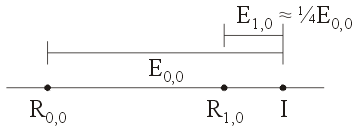Assumptions
We will assume that f(x) is a scalar-valued function of a single variable x and that f(x) is sufficiently differentiable.
Derivation
We know from the composite-trapezoidal rule that the error for approximating the integral is approximately
Let I represent the actual value of the integral:
Therefore, let E0,0 and E1,0 be the errors for approximating the integral with 1 and 2 interval, respectively:
I = R1,0 + E1,0
Graphically, this may be visualized in Figure 1 which shows these two errors. The point on the left is the actual value.

Figure 1. The errors E0,0 and E1,0.
If the error is reduced approximately by ¼ with each iteration, then E1,0 ≈ ¼ E0,0.
Looking at Figure 1, we note that if E1, 0 = ¼E0, 0, then R1, 0 − R0, 0 = ¾ E0, 0. Therefore, we have that
Therefore, we can solve for E0, 0 to get that
We can simplify this to get the approximation:
We will denote this approximation with R1,1.
To show that this really works, let us consider integrating the function f(x) = e-x on the interval [0, 2]. The actual answer is 0.8646647168.
If we approximate the integral with the composite-trapezoidal rule using 1, 2, and 4 intervals, we get the three approximations:
R1, 0 = ½(e-0 + 2e-1 + e-2)⋅1 ≈ 0.9355470828
R2, 0 = ½(e-0 + 2e-0.5 + 2e-1 + 2e-1.5 + e-2)⋅0.5 ≈ 0.9355470828
We see the error is going down, however, if we use our formula, we get:
R2, 1 = (4 R2,0 − R1,0)/3 ≈ 0.8649562404
The absolute errors are 0.00429 and 0.000292.
At this point, you may ask whether or not it is worth repeating the same process, but now with R1, 1 and R2, 1. Unfortunately, if we try this, we note that the error increases: the absolute error of (4 R2,1 − R1,1)/3 is 0.00104, which is worse than the error for R2, 1.
However, there is another fact we may note: If we consider the ratio of the error of R1, 1 over the error of R2, 1, we get 0.00429/0.000292 = 14.69. Previously, the error dropped by a factor of 4, here, it may not be unreasonable to postulate that the error is dropping by a factor of 42 = 16, however, we should show this.
To prove this fact, we must look at Taylor series:
If we represent the integral by I, then suppose that T(h) is an approximation of I using intervals of width h. In this case, a small change in:
Copyright ©2005 by Douglas Wilhelm Harder. All rights reserved.


